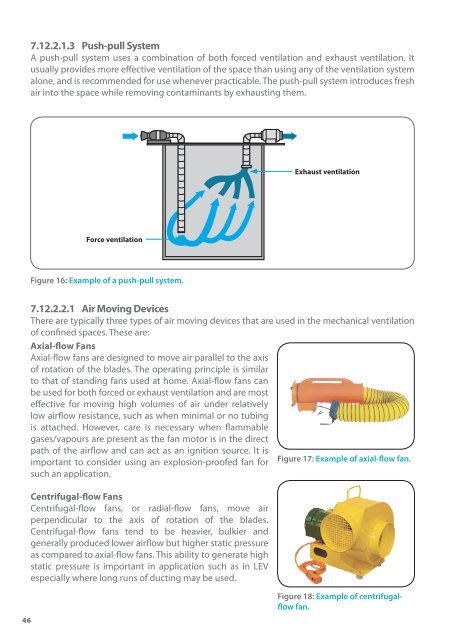Confined Spaces - Workplace Safety and Health Council
Confined Spaces - Workplace Safety and Health Council
Confined Spaces - Workplace Safety and Health Council
- No tags were found...
You also want an ePaper? Increase the reach of your titles
YUMPU automatically turns print PDFs into web optimized ePapers that Google loves.
7.12.2.1.3 Push-pull SystemA push-pull system uses a combination of both forced ventilation <strong>and</strong> exhaust ventilation. Itusually provides more effective ventilation of the space than using any of the ventilation systemalone, <strong>and</strong> is recommended for use whenever practicable. The push-pull system introduces freshair into the space while removing contaminants by exhausting them.Exhaust ventilationVenturi EductorVenturi eductors are powered by compressed air or steam.The air or steam is released into the eductor through anozzle at high velocity <strong>and</strong> this, in turn, induces air intothe inlet <strong>and</strong> forces it along the tube for discharge at highvelocity. Eductors are usually lighter, more compact <strong>and</strong>less expensive but they are not able to move large volumesof air <strong>and</strong> require a significant supply of compressed airor steam to operate. In addition, the high velocity airmovement may also generate static electricity that couldserve as an ignition source.Figure 19: Example of venturieductor.Force ventilation7.12.2.3 DuctingDucting is used widely <strong>and</strong> extensively to channel air to <strong>and</strong> from confined spaces. There are twomain types of ducting commonly used:• Flexible collapsible ducting; <strong>and</strong>• Flexible non-collapsible ducting.Figure 16: Example of a push-pull system.7.12.2.2.1 Air Moving DevicesThere are typically three types of air moving devices that are used in the mechanical ventilationof confined spaces. These are:Axial-flow FansAxial-flow fans are designed to move air parallel to the axisof rotation of the blades. The operating principle is similarto that of st<strong>and</strong>ing fans used at home. Axial-flow fans canbe used for both forced or exhaust ventilation <strong>and</strong> are mosteffective for moving high volumes of air under relativelylow airflow resistance, such as when minimal or no tubingis attached. However, care is necessary when flammablegases/vapours are present as the fan motor is in the directpath of the airflow <strong>and</strong> can act as an ignition source. It isimportant to consider using an explosion-proofed fan for Figure 17: Example of axial-flow fan.such an application.Centrifugal-flow FansCentrifugal-flow fans, or radial-flow fans, move airperpendicular to the axis of rotation of the blades.Centrifugal-flow fans tend to be heavier, bulkier <strong>and</strong>generally produced lower airflow but higher static pressureas compared to axial-flow fans. This ability to generate highstatic pressure is important in application such as in LEVespecially where long runs of ducting may be used.Figure 18: Example of centrifugalflowfan.It is important that the ducting length be as short as possible <strong>and</strong> that the number of elbowsor bends in the duct are kept to a minimum to reduce friction loss. Friction loss will reduce theefficiency of the ventilation <strong>and</strong> could potentially result in lower than the designed/calculatedcapacity.7.12.2.3.1 Flexible Collapsible DuctingFlexible collapsible ducting, such as plastic material tubing is commonly used. Such ducting lacksstructural support <strong>and</strong> can only be used for forced ventilation. While they usually cost less <strong>and</strong>are more flexible, the lack of structural support can often result in less effective ventilation due toincreased static pressure drop across the ducting.Particular care is required when using plastic material tubings as they are more susceptibleto wear <strong>and</strong> tear during use. It is also important to note that such plastic material tubings arecombustible. When they catch fire, smoke/toxic gas will be emitted <strong>and</strong> travel back to theconfined space.7.12.2.3.2 Flexible Non-collapsible DuctingAnother type of ducting used is the flexible non-collapsibleducting. It usually has a wire helix that provides the shape<strong>and</strong> prevents collapse. Such ducting offers strength, flexibility<strong>and</strong> can be compacted for storage. Flexible non-collapsibleducting can be used for both forced <strong>and</strong> exhaust ventilation.7.12.2.4 Effective VentilationAnother key component of ventilation in the confinedspace is to ensure that the ventilation systems in place areeffective. As a general principle, ventilation systems shouldbe set up with the following considerations:• Long confined space;• Deep confined space;Figure 20: Example of flexible noncollapsibleducting.46 47
















